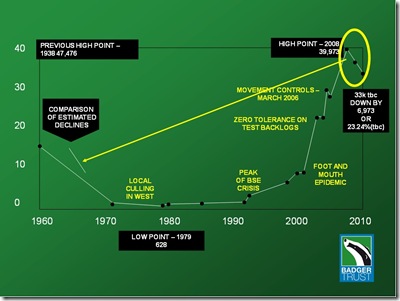Chart: Martin Hancox/Badger Trust
THE GENERALIST is like a dog with a bone.
Following a long conversation with Jack Reedy of the Badger Trust, it is clear that are some much deeper issues that have yet to be fully discussed or investigated by the mainstream media.
Jack sent me this chart which I am using in conjunction with TB statistics from Dairy Co. - a levy-funded, not-for-profit organisation working on behalf of Britain's dairy farmers – which come from DEFRA. Check out the charts here.
1938-1978: BOVINE TB CASES FALL DRAMATICALLY
By 1938 more than half of the cattle herds in Britain had bovine TB – and 47,476 animals were slaughtered that year. By a combination, as I understand it at present, of movement restrictions and animal testing, this was dramatically reduced to the point where, in 1978, only 628 individual animals were slaughtered. This is obviously worth investigating in more detail as to what exact methods were used and why it was so effective.
So what happened to the ‘wildlife reservoir’ of bovine TB during this period. Presumably badgers, and other animals, were also infected at this time but, for reasons unknown, this did not prevent or interfere with effective measures to reduce TB infection to near zero.
1980-1990
TB infections remain low.
1990-2008
Dramatic rise in cases of bovine TB correspond with two major farming crises – BSE and Foot & Mouth. These became a priority, The effects of these two crises was an increase of cattle being moved around the country before Movement Controls were set up in March 2006. The NFU, Jack says, would not agree to the pre-movement TB testing of animals during this period. This lends additional weight to the belief that cattle controls and testing are the key factor in dealing with bovine TB.
Click on: Historical TB data on Dairy Co and you ‘ll get some figures with the following comments:
Data for 2001 are not comparable with other years. During the outbreak of Foot and Mouth Disease, TB testing was significantly reduced and necessarily targeted to areas of higher risk.
Data for 2002 are not comparable with earlier years. Testing resources were concentrated on herds which were overdue their tests (because of the backlog caused by the Foot and Mouth Disease outbreak).
2008-2012
Cases peaked in 2008, with 39,973 TB-infected cattle being slaughtered. Here are the DEFRA figures since then (via Dairy Co.): 37,985 (2009), 31,965 (2010), 34,183 (2011). First six months of 2012 –18,213. So with some ups and downs, TB infection rates have fallen from the peak.
THE EFFECT OF INCREASED TB TESTING
One DEFRA chart shows the annual amount of TB testing. One factor in the rise of cases identified must be the increase in the no of tests. So in 2001 tests were made on 1,181,861 cattle and 6,156 were slaughtered. In 2011, 7,599,705 cattle were tested and 34,183 slaughtered.
THE NATIONAL DAIRY HERD
The size of the national dairy herd has fallen 7.2% in the last five years and now stands at 1.8m dairy cows. Dairy Co. make the assumption that 54.5% of the cattle slaughtered are dairy cattle. This means, they say, that in 2011, just 1% of he dairy herd were slaughtered due to TB.
I read somewhere (looking for reference) that the majority of dairy farmers are in their ‘60s. I discussed this with Jack who told me that in his knowledge many dairy farms are run with a skeleton staff of ageing farmers and relatives. He told me of one sizeable farm he knows which is run, without help, by the farmer (aged 78), his brother (74) and his wife who is in her late ‘60s. They have two sons and 4 0r 5 nephews but none of them want to work on the farm. He said dairy farms are suffering most from the TB problem.
WHY IS BOVINE TB SO PERSISTENT IN THE SW OF ENGLAND ?
Jack says its because these areas (including Gloucestershire, Worcestershire, Shropshire & Derbyshire) are good for both cattle and badgers (25% of the UK population). Climatic factors also play a role. (Conditions are very good for worms, which grow prolifically and provide badgers with more than 50% of their diet).
There are no figures available to show what proportion of TB cases are caused by transmission from cattle to cattle and from badgers to cattle.
| SEE PREVIOUS POSTS BELOW
|

No comments:
Post a Comment